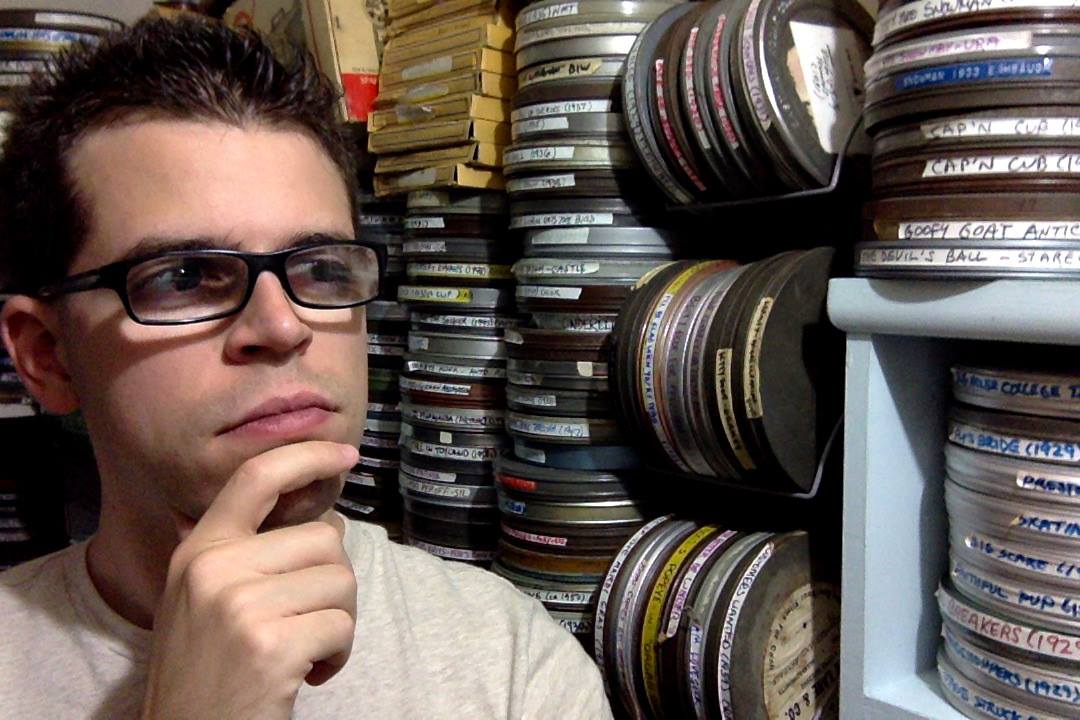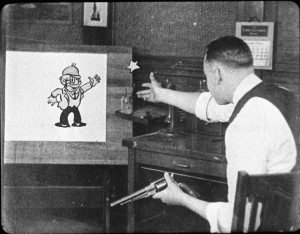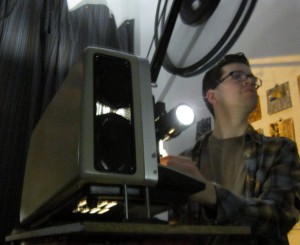I’ve known Tommy Stathes (rhymes with Mathis) for a few years, and his relentless drive to pick up cartoons is fascinating. Not only does he have original 1920s Kodascopes, but he collects old film prints of cartoons discarded in the 50s. He knows all about the different versions and cuts available. I hate to use the word obsessive (which might apply), but he certainly tries to get things right and tries to spread the word (and joy) about cartoons.
Like me, Tommy goes out on the road and does shows with live film projection. I particularly like the answer to his last question in which he talks about the need to promote, promote, promote… even though it might be a little embarrassing. But we’re both promoting stuff that few people know about and fewer people care about, so getting the word out is critical.
Those of you who follow this blog know that there’s a running thread about the fact that TCM has never even acknowledged my existence despite my efforts otherwise. It therefore, galls me to no end that TCM is now presenting the second special with Tommy’s efforts, and that they found him on the web because of his work. But NOOOOOO, they never found my site.
This leads to another topic: Tommy and I are constantly ribbing each other. Most film historians take themselves pretty seriously, but I don’t especially and neither does Tommy. If you don’t follow either of us on Facebook, then you may not know that he loves to poke fun at my hatred of Disco. He finds the most horrid Disco songs, sometimes bordering on unlistenable, and posts them on my page. He’s also fond of something called YouTube Poops, which I have to admit I don’t understand at all. (Mr. Stathes has asked me to clarify that he personally does not like YouTube Poops, and he doesn’t particularly understand them either, but he does enjoy posting them on my Facebook page to annoy me.)
In retaliation, I have posted things on his page playing up his resemblance to Senator Al Franken, and accusing him of running nothing but dupes. Dupes are inferior copy prints made on film. It’s considered a prank to wait until a collector’s pride-and-joy print hits the screen in a darkened theater and then yell DUPE.
Now, just because we have a Facebook war doesn’t mean we hate each other. Some people have actually taken our jokes seriously. I have to admit I have a grudging respect for the punk. I tried to let the air out of his tires, but he doesn’t drive.

Q1. You’re going to be on TCM with your own time slot in October. Please give this a plugola for the readers so we know what to expect. Keep in mind that I’m insanely jealous because it’s been a running tale here that TCM doesn’t even open my mail, much less give me a WHOLE TIME SLOT (you evil….)
That is correct! On the night of Monday, October 6th, TCM is dedicating the evening to rare, early and classic animation programming. I’ve provided an hour’s worth of rarely seen cartoons produced by the Bray Studios from 1913 to 1926. Bray was the first successful cartoon studio and many of animation history’s notable animators and studio heads got their start at Bray. The films come from my early animation archives and TCM asked me to co-host the program with Robert Osborne, which was a surreal task for me. Maybe you’ll see my stage fright showing through.
Q2. I’ve often said that film is the least-respected art form. But cartoons are the least-respected films. You save black and white silent cartoons, which most people would never even bother to watch. Why is it that you save them when almost no one else even cares about them?
I can’t tell just how sarcastic you’re being, because I know you like and collect some of them too, though, as you know, there are actual film historians and archivists who openly dump on cartoons. [Ed note: I wasn’t being sarcastic at all.] I care about these films and save them firstly through a personal interest in animation and in film history, and secondly because there have been no long-term, grand scale archiving efforts outside of a small handful of private collectors who have helped carry the torch in recent decades. I think every vein of pop culture history is inherently of value for several reasons, and it’s the niche I decided to research and preserve. You’d be surprised, though. For every seasoned film buff and historian who might turn their noses up at old cartoons, there are two dozen or more bright-eyed and fascinated ‘civilian’ attendees at my film screenings who are completely charmed by these films. At the end of the day, they ARE fun and charming films, whether you understand their history and value or not.

Q3. You’re particularly excited about John Randolph Bray. Please tell us a little about him and what makes him special.
As I began to hint at earlier, Bray is an extremely important figure in animation history. Without him, there would have been no bona fide animation industry, or its birth would have been delayed or played out in some other way. Bray was born in Michigan to a minister’s family in 1879, and though a creative and industrious person, he had an unsuccessful stint at college. Bray then got into journalism and finally cartooning once he moved to New York City in the early 1900s. By 1912, Bray had seen some of the earliest cartoons that were made, such as Winsor McCay’s Little Nemo (1911) and he began thinking of ways to translate his own comic characters to the screen. There’s an old rumor that he posed as a reporter to gain access to McCay’s studio, learned about animation techniques that way, and proceeded to run back home to start animating..and eventually patented those techniques as his own. Bray had a reputation for being unscrupulous that way, but these and other moves he made led to the founding of his studio upon securing a distribution contract with Pathe. Bray is often called the Henry Ford of animation–unlike no animators before him, he kept up with regular release schedules by applying the assembly line method of production in his studio, which, coupled with the animation techniques and shortcuts he developed himself and ‘borrowed’ from others, sped up the process and allowed theatergoers to begin seeing cartoons regularly. What many people don’t realize is that all this happened years before Disney became famous.
Q4. Tell us about the master want list. How often do you recover a cartoon that’s on it?
The infamous 16mm Silent Cartoon Want List! It’s a semi-complete list of silent-era cartoons that were known to be available in 16mm. Sometimes I go for a few months not finding anything on it, and sometimes I’ll find a dozen things in one month. You can never really know when stuff like this will turn up, or where. In the three or four years since I started the list, I estimate I’ve found and taken over two hundred titles off of it.
Q5. I am on record for hating cutesy Spielberg films, but you have a special love for …batteries not included. Why do you love this film so much? Doesn’t it have to do with a different type of preservation?
This is one of those situations where I saw the film and fell in love with it at age 5 or 6. So, Spielbergy and 80s Hollywood schmaltz aside (which I think is far more endearing than the quality of Hollywood films today), I love the film for several reasons. It takes place in disappearing Old New York, showing the boarded-up and abandoned period of the East Village. I’ve always loved distressed old buildings so a film centered on them is eye candy for me, as is any film taking place in my native New York prior to the 1990s. Then there’s a great story about an elderly couple who are trying to live out their final years in relative peace. The husband is trying to hold onto his old tenement building and the cafe he’s ran for decades, and the wife is battling dementia or Alzheimer’s disease. We see their and other residents’ struggles to carry out their lives while a real estate firm is trying to level their block for new luxury high-rises. For mainstream Hollywood, comedy and cheesy elements aside, I think the story is told quite beautifully. And how could you go wrong with Hume Cronyn and Jessica Tandy? I’m not usually big on sci-fi films so the elements of the story surrounding the little flying saucer repairmen is just a novelty to me, and not the focus of the story or the film. It’s fantasy-based but the conclusion is a victory for those of us who are sensitive to the plight of average people and those of us who are architectural preservationists.
Q6. I know you hate to speak before a group about your films. How is it that you spread the word about watching these films and that they’re cool? Do you get word of mouth at your shows?
Well, I wouldn’t say I hate doing it. It’s taken me a few years to get comfortable with it, and I don’t have the gift of gab in general, so it’s always a bit of a challenge. The word about my work and shows is spread through a lot of online promotion, word of mouth, and carefully written programs given out to attendees of a screening.

Q7. Your site is called Cartoons on FILM. Why are you so into FILM when most people want blu-ray or DVD? Is there something special about film for you?
I will always feel that there’s something intrinsically charming and special about holding a reel of film and seeing the little individual frames spooled up in a roll. I was born in the VHS age, but became instantly hooked when I saw a projector up close and all the care and mechanical components that went into making the apparatus work. While the technical working of machines isn’t my immediate forte, the joy of running a projector and showing people a movie off of a DVD or digital file is galaxies apart. Physical film and projectors win, hands down. There are always people who are also fascinated with seeing the projector up close and I think that’s half the attraction of my screenings.
Q8. It’s known that I constantly make fun of you. It’s actually upset some people, so I have to mention it here. Please state for the record that I really am mean, don’t like you, and am completely dismissive of your efforts. Feel free to mention the dupe joke if you like (even though I’ve had to declare a moratorium on it.)
If you’re really truly mean, then my name is Senator Al Franken. You and others also call me Senator constantly. I can’t win! People should know that you’re only [half] kidding when joking about my spotless original prints.
Q9. I’m aware that you especially like Disco music, which is an “art form” that I really do find vile and disgusting. I’ve often said that those of us who lived through the 70s are embarrassed about Disco. We don’t want to celebrate it at all. Just because this is your time here, please pick a relatively inoffensive Disco tune and I’ll post it with your comments about it. Lawrence Welk covers of Disco tunes are not to be discussed.
Oh, no need to torture you any further with a specific disco tune or my thoughts about it. All I’ll say is something I’ve said before: Not everyone who lived through the 70s is embarrassed about Disco. Sure, there was a lot of tackiness about some of the music within the genre and some of the culture connected with the music, but that’s true for most popular genres of any media. I think the tipping point and the reason a lot of people were annoyed by it is because it went overboard and infiltrated too many corners of life, rather than remain one genre of music and culture that you just heard about once in awhile outside of being a true disco king or queen in constant immersion. Some of it is very beautifully orchestrated music with a catchy, clean beat or melody. For me there’s a sentimental aspect to it and it’s one of several kinds of music I like. Get down on it and dance, dance, dance Dr. Film!
Q10. I hate it when people interview me and don’t really understand the point of what I do. What important question did I not ask you, and how would you answer that?
I think you got everything down pretty well, since you have a practically perfect understanding of what I do. I think there are two remaining questions: A. Where are you going from here, and what else do you want to do? B. What are some challenges involved in being an independent archivist and exhibitor?
My answers: A. My basic long-term goal is the same as it’s always been. Find, reunite and preserve as much silent-era animation as possible in one location. The additional things I want to do include finding more ways to get these films out to larger audiences, which includes home video, hopefully more broadcasts, and possibly some “modern” things like streaming, while retaining some sort of control and a method for making some kind of revenue. I’m not employed by an archive or university so, as you know, guys like us need to have a sort of proprietary lordship over the films we work with, even though our mission is to share them with the public as much as possible. B. Well, I just answered part of that question already! The only other thing I’ve had to learn is how to be my own promoter. Again, being independent means I have to promote, promote, promote, almost all on my own. I hope my friends understand that I’m posting about my shows and projects on social media all the time because that’s the only way I can keep it going and stay afloat, not simply because I’m obsessed with the medium. In my non-film walk of life, I barely even get into discussions about my work or film with the general population. I may be a showman and put on public events but if you ran into me in the street and had a chat with me, you would never know I do this sort of thing.

